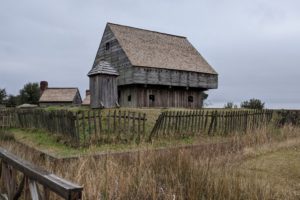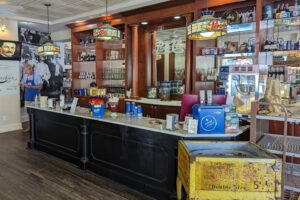Now that we’ve covered the beginning of the conflict at Fort Sumter and we’ve seen part of the fort as it looks today, come with us as we walk around the fort and see the informational signs. In this post we’ll look at the fighting back and forth from the time the Confederates took the fort and held off the Federal fighters until 1865. In the final post about Fort Sumter (part 22), we’ll find out how and why they left the fort and the rest of the defenses in the Charleston Harbor.

These cannon date from the Civil War, but they had huge advances over what was used in previous wars in terms of technology, increased power, range, and accuracy. Some large, old smoothbore cannon from the War of 1812 were “rifled and banded” to enhance firepower.




Did you notice the big, black bunker behind the cannons?

The big, black structure in the background is Battery Huger, a massive concrete structure that fits in the middle of the parade ground. It was completed in 1899 in response to the Spanish-American War. Changes to this battery have kept pace with modern technology, and the fort continued as part of the U.S. coastal defense system until the end of WWII.

Today’s look at Fort Sumter in the next picture shows that it’s changed radically since 1861 because of the changes that extended its life to the end of WWII. By the end of the war in 1865, Fort Sumter was in ruins. The first rebuilding came in the 1870s that kept remnants of the original structure.

powder magazine

Fort Sumter’s powder was stored in specially constructed rooms in the corner (angle) of the gorge wall. (The gorge was a lightly-armed rear wall facing inland that was vulnerable to attack from Morris Island.) Protecting gunpowder was, of course, critical.
The rear of the fort was considered a safe location because Fort Sumter was designed to face the sea, making it vulnerable to attack from land. When Confederate batteries bombarded the fort in April 1861, the resulting fire threatened the magazine, and it’s another reason why Major Anderson decided to evacuate rather than endanger his men.

But when the inner magazine with its store of small arms and munitions mysteriously exploded on December 11, 1863, some 11 Confederate soldiers were killed.

Early shelling at Fort Sumter left the gorge wall in ruins. Continued bombardment reduced the gorge to rubble, but Confederate soldiers and slaves reinforced the debris with sandbags and cotton bales, creating an earthwork that made the fort stronger than ever.
In the following 1851 photograph, the arch in the center is the original fort entry, or sally port. Later it was moved to where we entered today.

cannon placement upstairs and down
A disciplined, well-trained crew of 5 men could fire an accurate shot in less than 1 minute. Teamwork and timing during battle were essential to the crew of this 42-pounder smoothbore cannon.





The Columbiad is a rifled and banded cannon that’s mounted as a mortar (aimed upward). The photograph in the following picture shows a South Carolina delegation inspecting it after the Union troops left in April 1861.

They weren’t designed as mortars, but Federals, when they were here, mounted 5 of them at Fort Sumter for that purpose. This 10-inch columbiad could fire a 128-pound shell on a high arc. Union troops aimed these mortars at Charleston but never fired them.


As we look more closely at the battles that happened here during 1863-1865, let’s look again at the map of this area.

1863 -1865 siege of Fort Sumter
A close look at the wall in the next picture shows how the Union artillery shells were embedded in the brick. They were fired during one of the longest sieges in U.S. military history.

Batteries on Morris Island, about 1 mile away, and guns on Union warships in the harbor around the fort, shelled this Confederate stronghold for 22 months. The gorge wall facing Charleston was destroyed, and the left face wall was severely damaged.

The right face of the fort wall had the least damage of any of Fort Sumter’s walls during the Union bombardment. After the war, the fort’s first-tier casemates were rearmed with 100-pounder rifled Parrott cannon. These guns came from Morris Island and could have been the same guns the Union used to fire on Fort Sumter. Eleven Parrott guns occupy these casements today.



As we’ve learned previously, Southern blockade-runners continued to slip in and out of Charleston Harbor, carrying cargo important to the economic and military survival of the South. Using neutral ports like Bermuda and Nassau, these ships brought food, medicine, weapons, ammunition, and manufactured goods from Europe. They took cotton with them from Charleston, as well as carried diplomats, dispatches, and various products and valuables.

April 7, 1863 – ironclads attack
The Union Navy sent its new force of ironclad warships–8 monitors and the frigate New Ironsides–to attack Fort Sumter. (Ironclads are steam-propelled warships protected by iron or steel armor plates that were constructed from 1859 to the early 1890s. Monitors were relatively small warships that are neither fast nor strongly armored but could carry disproportionately large guns.)

August 22, 1863 – Swamp Angel
In 1863, Union forces built a battery about 2 miles away in the marsh on lower Morris Island. They mounted an 8-inch Parrott rifle called the Swamp Angel. This huge gun fired 150-pound shells aimed at the city of Charleston 5 miles away.
The Swamp Angel’s first shot at 1:30 a.m. on August 22 caused panic in Charleston, shattering the city’s security. Its brief career ended the following day when the overcharged gun burst while firing its 36th round.


July 1863 – Fort Sumter
The photograph on the left in the next picture is from 1861; on the right is the fort in 1863. In July of 1863, Union troops landed on Morris Island and advanced 2/3 of the way up to the island to a Confederate stronghold known as Battery Wagner.

After 2 months, they drove the defenders out. From this location, Union artillery set up powerful siege battles at Cummings Point where they shelled Fort Sumter at point-blank range, reducing the once proud walls to a mere pile of rubble.
As the walls became more and more damaged, the Confederate soldiers inside became stronger. Slaves piled debris into huge breastworks that were 20-feet thick and reinforced them with cotton bales, sandbags, and other material, making the fort impregnable to artillery.
July 18, 1863 – Union attacked Fort Wagner near Morris Island
Confederate batteries were hidden in the dunes of Morris Island that commanded the approach to Charleston Harbor.

Union forces needed this Island, a key location for attacking Fort Sumter less than 1 mile away. On July 10, 1863, they attempted a direct assault but failed. Changing tactics, the Union then subjected Fort Wagner to a 2-month siege. The Confederate soldiers finally evacuated, abandoning Morris Island on September 6.

September 8, 1863 – night attack
The Union forces attempted to storm Fort Sumter only once during the Civil War. On this night, a Union tugboat towed 500 sailors and marines in small boats to within 400 yards of the fort. When they tried to attack, the Confederates were ready for them. As the leading boats landed, the defenders opened fire, hurling grenades and bricks down upon the assailants. Guns of Fort Moultrie and a Confederate gunboat opened fire. The remaining boats retreated, and 124 Union men stranded here were killed, wounded, or captured.

throughout 1863
The next sign described what it was like for the Confederate soldiers to hold the fort in 1863 when a shell exploded on the parade ground.

“Daily dispatches from Fort Sumter in 1863 tell of the struggle:
“August 14–A force of 470 laborers and mechanics has been engaged, in two reliefs, day and night upon the defenses of the fort. . . .
“August 18–The enemy opened fire with rapidity at 5 a.m. and continued til 7 p.m. Eight hundred and seventy-six shots and shells were fired; 452 struck outside, 244 inside, and 180 passed over.
“August 24–Force of 210 negroes engaged all night in strengthening western magazine . . . . The flag-staff was shot away twice. The whole garrison worked all night.
“September 4–There is now not a single gun en barbette [the practice of firing a cannon over a parapet rather than through an embrasure in a fortification’s casemate]. . . . The northeastern and northwestern terre plein [the top, platform, or horizontal surface of a rampart, on which cannon are placed, protected by a parapet] have fallen in. . . . The greater portion of southern wall is down. The eastern wall is very nearly shot away. . . .”
For almost 2 years (1863-1865), Confederate soldiers endured night-and-day pounding from Union cannons that reduced most of the fort to rubble. But the Confederate garrison wouldn’t surrender.
To read more about how/when the Confederates left Fort Sumter and the Union came back, see the next post with information from the fort’s museum.
port of Charleston then and now
Since 1670, this well-protected harbor has been a center for shipping and trade. By 1770, it was America’s 3rd busiest port. Along this waterfront ships loaded cargo and departed for Europe, Africa, the Caribbean, and other American ports. Exports included timber, indigo, furs, leather, and rice bound for England and meat and lumber were bound for the Caribbean. Ships returned with such imports as rum, sugar, slaves, and luxury items. By the 1850s, cotton replaced rice as Charleston’s dominant export.
In the mid-1800s, as manufacturing grew in the Northeast and railroads expanded westward, Charleston didn’t keep pace with the nation’s growth. Then came the Civil War. Its aftermath would dominate Charleston’s economic recovery for years.

Today the port of Charleston has regained its prosperity. It’s the largest container port along the Southeast and Gulf Coasts and one of the largest in the country, handling millions of 20-foot container units annually. The port also handles “breakable” cargo, such as vehicles, machinery, boats, and heavy equipment.
As of 1948, Fort Sumter has been a National Monument. Its top two tiers are gone, and the center is dominated by Battery Huger, a concrete artillery emplacement, that was built here in 1898-1899 during the Spanish-American war.

If you’d like more information about this place and this time and how/why the Confederates left Fort Sumter, read the next post with information from the fort’s museum.




